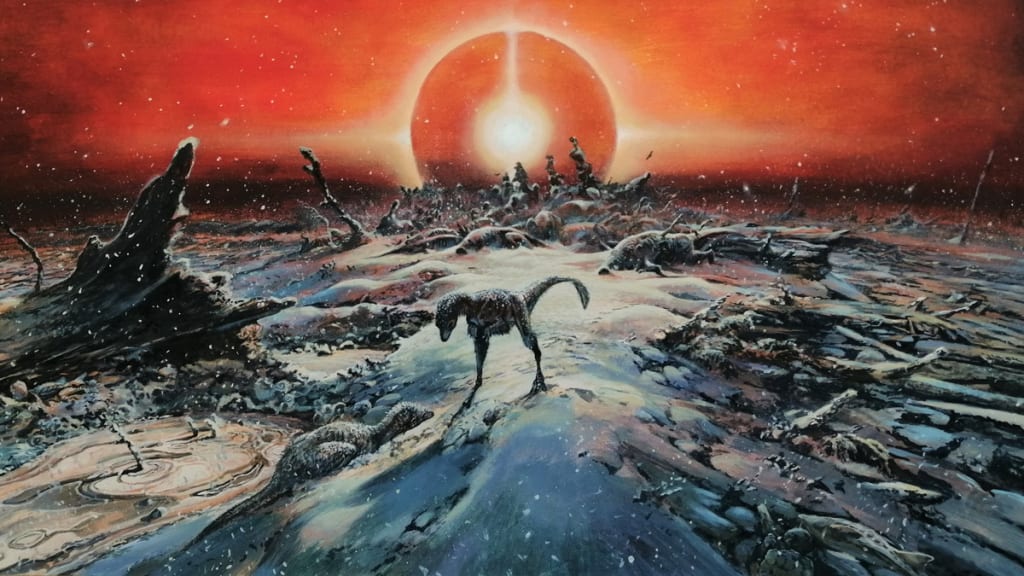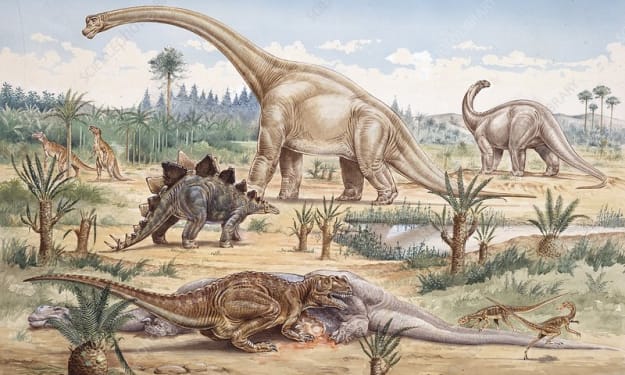
NASA researchers have developed a new timeline showing the impact of a giant asteroid 65 million years ago on Earth, which almost wiped out the dinosaurs. The asteroid's impact into shallow waters in the Gulf of Mexico led to additional disasters such as rocks falling from the sky, wildfires, and tsunamis inundating distant shorelines. The researchers used high-resolution photography, microscopy, computed tomography imaging, and magnetic measurements to create a timeline of the chaos that occurred.
The asteroid, which was between 11 to 80 kilometers wide, hit Earth's atmosphere at 72,420 kilometers per hour. Smaller space rocks, called meteors, decelerate rapidly at high altitudes, while some larger pieces of rock survive and fall to Earth. The mountain-sized Chicxulub asteroid hit Earth's atmosphere like throwing a boulder into a puddle, maintaining its velocity and plummeting through the entire 60 miles of atmosphere in just three seconds. The asteroid shrieks over Central America, emitting sonic booms that would shatter eardrums across all continents.
The asteroid's rapid fall caused intense compression, causing the air to heat to thousands of degrees almost instantly. The compressed superheated air vaporized much of the shallow sea that covered the Yucatán peninsula, and milliseconds later, the rock plunged through what's left and slammed into bedrock. This chain reaction of events resulted in soil and rock flowing like fluids, causing the Earth to move like a double-splash of a cannonball in a swimming pool.
The Chicxulub impactor, a massive asteroid, caused a massive earthquake and tsunami across the globe. The impact caused a massive wave of pressure, causing fault-slipping earthquakes and tsunamis. The asteroid's kinetic energy, which is more than one-billion kilojoules of energy, excites molecules to temperatures far hotter than the sun's surface. The heat rips electrons from atoms, ionizing the air into an expanding fireball of plasma. The blast wave, which reaches speeds of over 1,600 kilometers per hour, vaporizes cities like Texas, New York, and Buenos Aires. Waves in Earth's crust radiate away from the impact zone, triggering fault-slipping earthquakes and tsunamis. The impact also caused waves to reach every coastline on the planet, with the ocean sweeping away anything in its path. The asteroid's splash accounts for 25 trillion tons of earth that it launches on ballistic trajectories, some at speeds exceeding Earth's escape velocity. The majority of ejected debris returned back to Earth within an hour, forming glass-like chunks called tektites, which pelt the Earth at speeds ranging from 160 to 320 kilometers per hour.
The Chicxulub asteroid, a massive asteroid, caused a devastating impact on Earth. The tektites, which were ejecting thermal radiation, set fires across the planet, causing most trees to burn and birds to extinction. The asteroid also ejected oil and sulfur, causing massive storm clouds and acid rain. The soot layer, which remained in the atmosphere for two to three years, reduced sunlight reaches Earth's surface by 90%. The initial heat led to a deep freeze, with global temperatures dropping by almost 50 degrees. The only places to avoid this deep freeze were Madagascar, India, and Indonesia, which were tropical islands during this time. Researchers using a supercomputer studied asteroid evolution using data from known asteroids, suggesting that the Chicxulub asteroid likely originated from the Oort cloud.
NASA has revealed that a 330-meter long asteroid named 4660 Nereus screamed past Earth at a speed of 6.5 kilometers per second, potentially hitting Earth once every 250 to 730 million years. The asteroid is expected to come within 1.1 million kilometers of Earth on Valentine's Day in 2060. To defend Earth from a giant space rock, NASA's DART mission aims to test if a spacecraft can autonomously navigate to a target asteroid and intentionally collide with it, causing an kinetic impact that could push the asteroid off a collision course with Earth. The collision is expected to change the speed of the moonlet by a fraction of 1%.
About the Creator
PDZICOX
Everyday articles.
The information on this page will help you learn more about mystery, news, facts, psychology, geography and more. We will provide the best resources for learning about these topics.






Comments
There are no comments for this story
Be the first to respond and start the conversation.